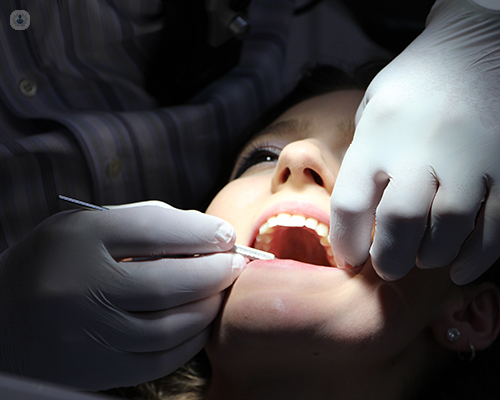Dental veneers – are they the right choice for me?
Escrito por:Ever wondered how celebrities all seem to have those dazzling, bright smiles? Many of them have dental veneers to improve the appearance of their own teeth. Veneers are manufactured caps placed over the front of your own teeth. Dr David Bloom, a leading restorative and cosmetic dentist, explains the different types of veneers available, and other measures used in restorative dentistry.

What are the advantages of porcelain veneers?
A porcelain veneer is a facing of porcelain that is bonded onto the front of your teeth. We can sometimes correct worn teeth with just edge bonding, and we can also do composite veneers. However, porcelain is probably going to last longer than any of those.
A porcelain veneer is added onto the front of the tooth, and if we are doing a single tooth, we would have to make space for that veneer (generally about half a millimetre). However, the more we can add to the front of the tooth, the less we have to drill. So, if we can add 0.2 or 0.3mm, we only have to remove 0.2 or 0.3 of a millimetre. If we can add the whole half a millimetre without making the teeth too wonky, then we're in the realms of a prepless veneer. A veneer works best when it is bonded to enamel and so it is very important that we think additively and don't just drill teeth away. Done correctly, porcelain veneers should have a life expectancy of 10 to 15 years, or possibly more. I think it is important to realise, however well we do anything, it will have a lifespan and so being conservative is the most important thing to consider.
How would I know what veneers would look on me?
We have a few ways to show you what veneers can look like and the first option is that we take photos and we can do a digital imaging of that photo to give a simulation. The problem with this method is that it is not showing you the veneers in your mouth. Therefore, the best way is if we can put plastic material onto your teeth. To do so, I would take moulds of your teeth and ask the lab to wax up the teeth onto that model, giving a 3D preview of the shape of the veneers. If I have a mould of that and I fill that with plastic material, I can put that on your teeth without touching your teeth. We call this a visual trial and it is a real simulation in your mouth of what the new teeth could look like. We can then shape this look until we have the final result that you are happy with. We can also now mill 3D veneers (plastic temporary veneers) that we can also put on your teeth. Hence, it is entirely possible before touching your teeth to show you exactly what your new smile could look like.
How long do porcelain veneers last?
Porcelain veneers done correctly should have a life expectancy of 10 to 15 years. However, for that longevity, we need to be ensuring that we are bonding to the enamel; and so make sure that the design is additive rather than just reducing your teeth. Composite veneers have a place, but their life expectancy is going to be less than porcelain (typically five to seven years because they are not going to keep their lustre for as long). Edge bonding, which is not a veneer, but correction of the worn edges of teeth, is also an option and that can be done without any preparation. However, porcelain veneers are going to have the longest life expectancy. It is important to remember that however well we do anything as a dentist, it is going to have a lifespan, but you can expect 10 to 15 years.
What is restorative dentistry and how is a tooth crown implant carried out?
Restorative dentistry is everything ranging from simple fillings for small amounts of decay. When we replace fillings the tooth gets weakened which is when we move on to using a tooth coloured inlay or onlay to help reinforce the tooth. We also have the option of dental crowns (also known as caps) used on teeth that cannot be restored with an onlay alone.
Crowns can also be used to support false teeth (i.e. a bridge). However, sometimes when a bridge fails it will tend to take one of the supporting teeth with it. Therefore, nowadays we tend to use dental implants instead. A dental implant is a hollow titanium screw that is placed into the bone. The bone fuses onto it and after three to four months the bone and the implant are integral and we can then quite literally screw a new tooth into your implant. Hence, there are many options to replace and restore teeth.
If you are considering veneers or restorative dentistry, make an appointment with an expert.


